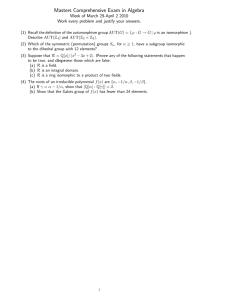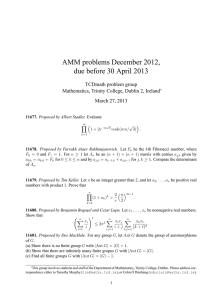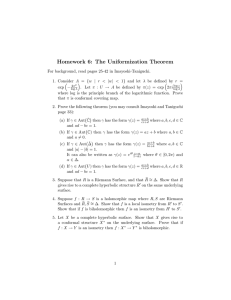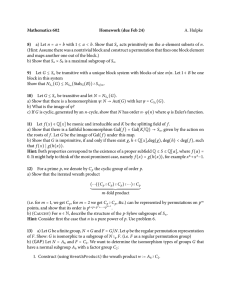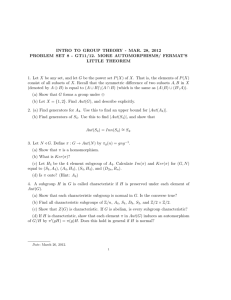Mathematics 567 Homework (due Feb 14) 13) A. Hulpke
advertisement
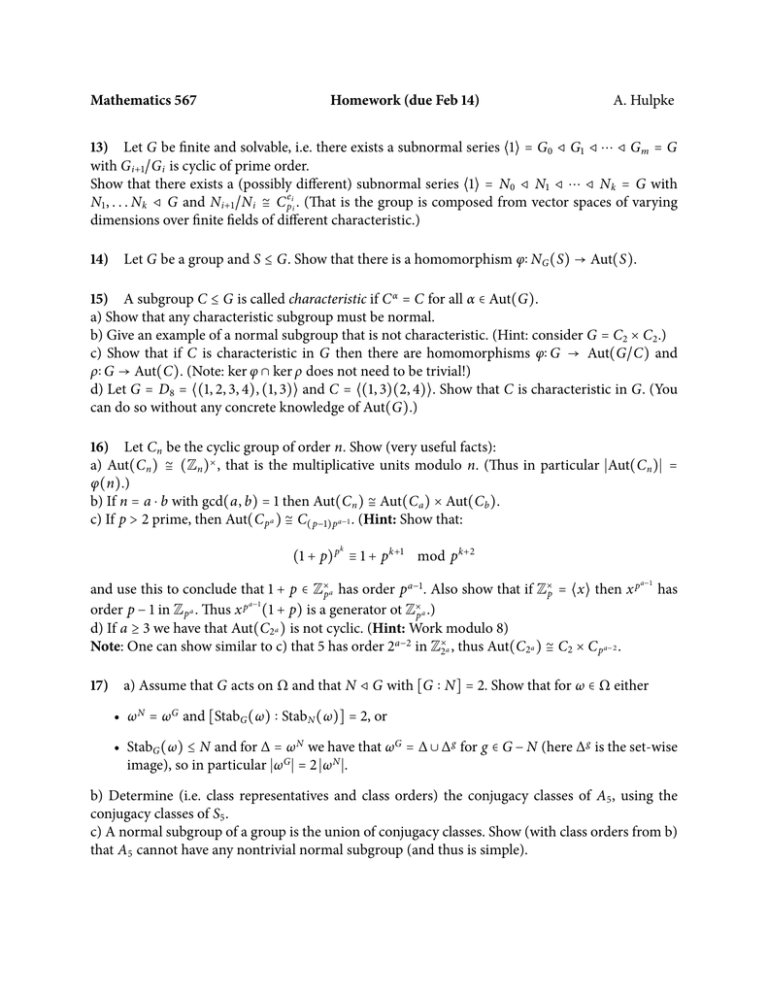
Mathematics 567 Homework (due Feb 14) A. Hulpke 13) Let G be finite and solvable, i.e. there exists a subnormal series ⟨1⟩ = G0 ⊲ G1 ⊲ ⋯ ⊲ G m = G with G i+1 /G i is cyclic of prime order. Show that there exists a (possibly different) subnormal series ⟨1⟩ = N0 ⊲ N1 ⊲ ⋯ ⊲ N k = G with N1 , . . . N k ⊲ G and N i+1 /N i ≅ C pe ii . (That is the group is composed from vector spaces of varying dimensions over finite fields of different characteristic.) 14) Let G be a group and S ≤ G. Show that there is a homomorphism φ∶ NG (S) → Aut(S). 15) A subgroup C ≤ G is called characteristic if C α = C for all α ∈ Aut(G). a) Show that any characteristic subgroup must be normal. b) Give an example of a normal subgroup that is not characteristic. (Hint: consider G = C2 × C2 .) c) Show that if C is characteristic in G then there are homomorphisms φ∶ G → Aut(G/C) and ρ∶ G → Aut(C). (Note: ker φ ∩ ker ρ does not need to be trivial!) d) Let G = D8 = ⟨(1, 2, 3, 4), (1, 3)⟩ and C = ⟨(1, 3)(2, 4)⟩. Show that C is characteristic in G. (You can do so without any concrete knowledge of Aut(G).) 16) Let C n be the cyclic group of order n. Show (very useful facts): a) Aut(C n ) ≅ (Zn )× , that is the multiplicative units modulo n. (Thus in particular ∣Aut(C n )∣ = φ(n).) b) If n = a ⋅ b with gcd(a, b) = 1 then Aut(C n ) ≅ Aut(C a ) × Aut(Cb ). c) If p > 2 prime, then Aut(C p a ) ≅ C(p−1)p a−1 . (Hint: Show that: k (1 + p) p ≡ 1 + p k+1 mod pk+2 and use this to conclude that 1 + p ∈ Z×p a has order p a−1 . Also show that if Z×p = ⟨x⟩ then x p a−1 order p − 1 in Z p a . Thus x p (1 + p) is a generator ot Z×p a .) d) If a ≥ 3 we have that Aut(C2a ) is not cyclic. (Hint: Work modulo 8) Note: One can show similar to c) that 5 has order 2a−2 in Z×2a , thus Aut(C2a ) ≅ C2 × C p a−2 . a−1 has 17) a) Assume that G acts on Ω and that N ⊲ G with [G ∶ N] = 2. Show that for ω ∈ Ω either • ω N = ωG and [StabG (ω) ∶ StabN (ω)] = 2, or • StabG (ω) ≤ N and for ∆ = ω N we have that ωG = ∆ ∪ ∆ g for g ∈ G − N (here ∆ g is the set-wise image), so in particular ∣ωG ∣ = 2 ∣ω N ∣. b) Determine (i.e. class representatives and class orders) the conjugacy classes of A5 , using the conjugacy classes of S5 . c) A normal subgroup of a group is the union of conjugacy classes. Show (with class orders from b) that A5 cannot have any nontrivial normal subgroup (and thus is simple).
